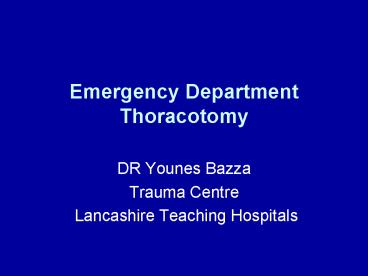Emergency Department Thoracotomy PowerPoint PPT Presentation
1 / 28
Title: Emergency Department Thoracotomy
1
Emergency Department Thoracotomy
- DR Younes Bazza
- Trauma Centre
- Lancashire Teaching Hospitals
2
Introduction
- Many surgeons still share the pessimism of
Bilroth when discussing emergency thoracotomy.
Nevertheless, current studies have shown survival
rates approaching 60 in selected groups of
patients. Shortly after Bilroth dismissed surgery
for cardiac injury, the first report of
successful management of traumatic cardiac injury
was published by Rehn in 1900.
3
First thoracotamy
- The first successful prehospital thoracotomy and
cardiac repair was carried out by Hill on a
kitchen table in Montgomery, Alabama in 1902.
4
(No Transcript)
5
Indications
- While the technique of emergency thoracotomy is
fairly standard, the indications for performing
surgery remain a source of controversy. - The following are a suggested set of guidelines
for general use. In practice these will vary with
local resources and skill availability.
6
Accepted Indications
- Penetrating thoracic injury - Traumatic arrest
with previously witnessed cardiac activity
(pre-hospital or in-hospital) - Unresponsive
hypotension (BP lt 70mmHg) - Blunt thoracic injury - Unresponsive
hypotension (BP lt 70mmHg) - Rapid
exsanguinations from chest tube (gt1500ml
7
Relative Indications
- Penetrating thoracic injury - Traumatic arrest
without previously witnessed cardiac activity - Penetrating non-thoracic injury - Traumatic
arrest with previously witnessed cardiac activity
(pre-hospital or in-hospital - Blunt thoracic injuries - Traumatic arrest
with previously witnessed cardiac activity
(pre-hospital or in-hospital)
8
Contraindications
- Blunt injuries - Blunt thoracic injuries with
no witnessed cardiac activity - Multiple
blunt trauma - Severe head injury
9
Emergency Department ThoracotomyRationale
- Overall survival of patients undergoing emergency
thoracotomy is between 4 and 33 depending on the
protocols used in individual departments. - The main determinants for survivability of an
emergency thoracotomy are the mechanism of injury
(stab, gunshot or blunt), location of injury and
the presence or absence of vital signs.
10
Mechanism of Injury
- Penetrating thoracic injury the survival rate is
fairly uniform at 18-33. - Stab wounds having a far greater chance of
survival than gunshot wounds. - Isolated thoracic stab wounds causing cardiac
tamponade probably have the highest survival
rate, approaching 70. - In contrast, gunshot wounds injuring more than
one cardiac chamber and causing exsanguinations
have a much higher mortality.
11
(No Transcript)
12
Location of Injury
- Almost all survivors of emergency thoracotomy
suffer isolated injuries to the thoracic cavity. - Cardiac injuries have the highest survival rates.
- Outcome for single chamber versus multiple
chamber injuries. - Great vessels and pulmonary hula's injuries
carry a much higher mortality. - Injuries to the chest wall rarely require
emergency thoracotomy.
13
Management of Traumatic Arrest
- Hypoxic arrest
- Massive haemorrhage
- Cardiac tamponade
- Massive haemorrhage
- Anaesthesia
- Fluid Therapy
- Inotropic support
14
Hypoxic arrest.
- Tracheal intubation is mandatory.
- Ventilation with 100 oxygen.
- Especially true of paediatric head injuries.
15
Massive haemorrhage
- Performing bilateral thoracostomies
- Control of haemorrhage.
- Be careful with intravenous fluid therapy.
- Fluid therapy prior to haemorrhage control
worsens outcome in penetrating thoracic trauma. - Fluid challenge.
- Fluid administration should be halted until
haemorrhage control is achieved.
16
Cardiac tamponade
- The classic signs of distended neck veins and
muffled heart sounds are almost universally
absent in traumatic cardiac tamponade. - Failing the needle pericardiocentesis.
- FAST ultrasound scan.
17
Fluid Therapy
- Large-volume fluid therapy should be avoided
prior to haemorrhage control. - Once haemorrhage is controlled patients will need
rapid correction of hypovolaemia to refill the
heart and restore perfusion to non-vital organ
systems. - Patients will be cold and profoundly
coagulopathic. - Blood and component therapy should be warmed and
administered rapidly AFTER haemorrhage is
controlled.
18
Inotropic support
- The use of adrenaline (or other inotropes) is
contra-indicated in the presence of hypovolaemia. - Inotropes may be required after control of
haemorrhage and cardiac repair.
19
Approach
- A supine anterolateral thoracotomy.
- A left sided approach is used in all patients in
traumatic arrest and with injuries to the left
chest. - Patients who are not arrested but with profound
hypotension and right sided injuries have their
right chest opened first.
20
Relief of tamponade
- The pericardium is opened longitudinally.
- Avoid damage to the phrenic nerve, which runs
along its lateral border. - Make a small incision in the pericardium with
scissors and then tear the pericardium
longitudinally with your fingers - this will
avoid lacerating the phrenic nerve. Evacuate any
blood and clot from the pericardial cavity.
21
(No Transcript)
22
Control of hemorrhage
- Cardiac wounds should be controlled.
- Direct finger pressure
- A Foley catheter
- Satinsky clamps can be placed across wounds of
the atria to control hemorrhage - Obstruct venous inflow to allow repair
- Direct sutured using non-absorbable 3/0 sutures
23
(No Transcript)
24
(No Transcript)
25
Internal cardiac massage
- Internal cardiac massage should be started as
soon as possible following relief of tamponade
and control of cardiac hemorrhage. - A two-handed technique produces a better cardiac
output and avoids the low risk of cardiac
perforation with the one-handed maneuver.
26
Internal Defibrillation
- Internal pads
- Use the shock 8, 8, and 16 j.
27
Outocome
- Close the chest
- Chest Drains
- Pericardiac Drains
- Transfer the patient for ICU
28
Conclusion
- Overall survival of patients undergoing emergency
thoracotomy is between 4 and 33 depending on the
protocols used in individual departments. - The main determinants for survivability of an
emergency thoracotomy are the mechanism of injury
(stab, gunshot or blunt), location of injury and
the presence or absence of vital signs.

